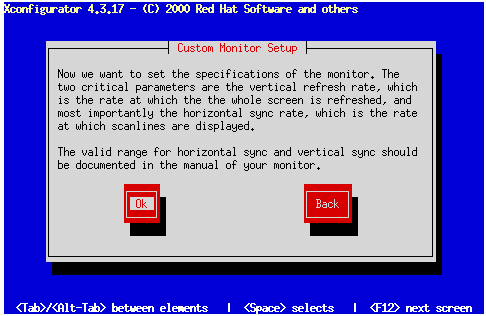Configuring the X Window System
The Xconfigurator utility gives you the opportunity to configure the X server for your system.
First, Xconfigurator presents a list of monitors (see Figure 14-43). If your monitor is listed, select it and press Enter. Otherwise, select Custom.
If you select a monitor from the list, you will next enter your video memory, see Figure 14-48.
If you select Custom, Xconfigurator prompts you to select the horizontal sync range and vertical sync range of your monitor (these values are usually available in the documentation which accompanies your monitor, or from your monitor's vendor or manufacturer).
 | Caution |
|---|---|
Do not select any range that exceeds the capacity of your monitor. If you do this, it is possible you may overclock your monitor and damage or destroy it. |
Choose a horizontal sync range for your monitor (see Figure 14-45). Be sure not to choose a range outside of your monitor's capacity. For custom settings, refer to Figure 14-47.
Next, choose a vertical sync range.
If you chose to enter custom monitor settings, please enter both the horizontal and vertical sync rages for your monitor (see Figure 14-47).
After you've selected your monitor (and its settings), you must choose the amount of memory present on your video card (see Figure 14-48).
If you are not sure how much memory your card has, consult the documentation accompanying your video card. Choosing more memory than is present in your card will not damage it, but may cause the XFree86 server to start incorrectly.
Next, choose a clockchip setting if your video card supports it (if it has one). The recommended choice is No Clockchip Setting, since XFree86 can automatically detect the proper clockchip in most cases.
The Probe for Clocks screen (see Figure 14-50) prompts you to allow the installation program to detect what video modes your video card and monitor are capable of using.
You should select Probe for best results. If you allow the installation program to detect these modes for you, your choices for video modes (see Figure 14-51) may be reduced based on your video card and monitor capabilities.
However, if a previous attempt to probe video modes ended with a bad result (such as having to reboot your system), you should choose Skip and then choose your preferred video modes (see Figure 14-52).
To choose your preferred display mode (see Figure 14-51 and Figure 14-52), select one or more modes by pressing Space.
 | Tip |
|---|---|
Minimum recommended settings for video modes are 16 bit for most applications (video modes set higher than 16 bit tend to run more slowly) in 1024x768. |
Do not select a mode that exceeds the capacity of your monitor.
Once you've either selected the default video mode or specified a different mode, the Starting X dialog lets you test your X configuration.
If you select OK, you'll have the opportunity to go back and enter different configuration values should there be an error. If there is no error, X will start, and a small display window will ask you if you can read its contents clearly; using the mouse, click Yes within ten seconds. Then you will be asked whether you want X to start when the system boots.
In most cases, X configuration is complete at this point, and you'll see the completion screen.
Xconfigurator then saves all of your choices to the configuration file /etc/X11/XF86Config. To modify your X configuration after installation, issue the Xconfigurator command as root.










